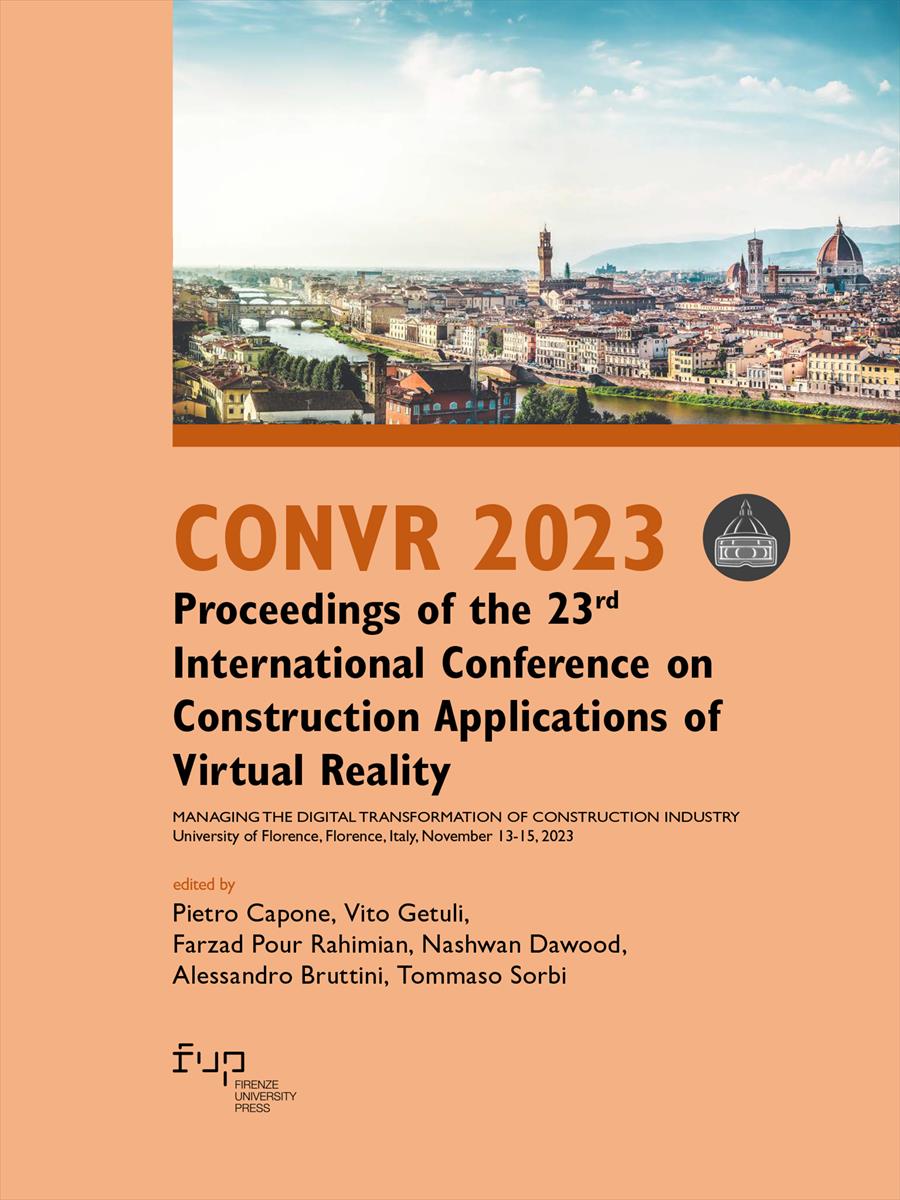- CONVR 2023 - Proceedings of the 23rd International Conference on Construction Applications of Virtual Reality
- Edited by Pietro Capone, Vito Getuli, Farzad Pour Rahimian, Nashwan Dawood, Alessandro Bruttini, Tommaso Sorbi
Carbon Tracking in the Building Sector: A ‘CABBAGE’ Framework
- Jiajia Wang
- Geoffrey Qiping Shen
- Fan Xue
- © 2023 Author(s) |
- CC BY-NC 4.0
- DOI: 10.36253/979-12-215-0289-3.108
The great challenge of global climate change urges world economies to reduce greenhouse gas emissions and promote sustainable development, where the building sector plays a vital role. Carbon tracking technology is one of the keys to capturing carbon emissions for sustainable construction such as net-zero buildings. This paper reviews five key carbon tracking technologies – life cycle assessment (LCA), energy modeling, building operation monitoring, carbon accounting software, and green certification and rating systems. With summarized advantages, beneficiaries, and limitations of the five technologies, we propose a Carbon Tracking ‘Cabbage’ (CTC) framework that incorporates all carbon tracking tools as inner technological layers for multiple stakeholders at multiple stages of construction management. The main contribution of this paper is the CTC framework that rationalizes the scopes and adoption strategies of carbon tracking technologies by collaborative stakeholders to achieve informed decision-making, implement effective carbon reduction strategies, and subsequently contribute to climate change mitigation actively
- Keywords:
- Carbon tracking; Building sector; Carbon tracking cabbage framework; multi-stakeholder; Technology adoption,
The University of Hong Kong, China
The Hong Kong Polytechnic University, Hong Kong - ORCID: 0000-0002-3111-2019
The University of Hong Kong, China - ORCID: 0000-0003-2217-3693
- Bilec, M. M., Ries, R., & Matthews, H. S. (2010). Life-Cycle Assessment Modeling of construction processes for buildings. Journal of Infrastructure Systems, 16(3), 199–205. DOI: 10.1061/(asce)is.1943-555x.0000022
- Chang, Y., Huang, Z., Ries, R., & Masanet, E. (2016). The embodied air pollutant emissions and water footprints of buildings in China: a quantification using disaggregated input–output life cycle inventory model. Journal of Cleaner Production, 113, 274–284. DOI: 10.1016/j.jclepro.2015.11.014
- Dodoo, A., Gustavsson, L., & Sathre, R. (2014). Lifecycle carbon implications of conventional and low-energy multi-storey timber building systems. Energy and Buildings, 82, 194–210. DOI: 10.1016/j.enbuild.2014.06.034
- Geng, J., Wang, J., Huang, J., Zhou, D., Bai, J., Wang, J., Zhang, H., Duan, H., & Zhang, W. (2022). Quantification of the carbon emission of urban residential buildings: The case of the Greater Bay Area cities in China. Environmental Impact Assessment Review, 95, 106775. DOI: 10.1016/j.eiar.2022.106775
- Hong, J., Shen, G. Q., Feng, Y., Lau, W. S., & Mao, C. (2015). Greenhouse gas emissions during the construction phase of a building: a case study in China. Journal of Cleaner Production, 103, 249–259. DOI: 10.1016/j.jclepro.2014.11.023
- Kang, G., Kim, T., Kim, Y. K., Cho, H., & Kang, K. (2015). Statistical analysis of embodied carbon emission for building construction. Energy and Buildings, 105, 326–333. DOI: 10.1016/j.enbuild.2015.07.058
- Khalili, A., & Chua, D. K. H. (2013). IFC-Based Framework to Move beyond Individual Building Elements toward Configuring a Higher Level of Prefabrication. Journal of Computing in Civil Engineering, 27(3), 243–253. DOI: 10.1061/(asce)cp.1943-5487.0000203
- Li, L. J., & Chen, K. (2017). Quantitative assessment of carbon dioxide emissions in construction projects: A case study in Shenzhen. Journal of Cleaner Production, 141, 394–408. DOI: 10.1016/j.jclepro.2016.09.134
- Liu, G., Gu, T., Xu, P., Hong, J., Shrestha, A., & Martek, I. (2019). A production line-based carbon emission assessment model for prefabricated components in China. Journal of Cleaner Production, 209, 30–39. DOI: 10.1016/j.jclepro.2018.10.172
- Liu, G., Yang, H., Fu, Y., Mao, C., Xu, P., Hong, J., & Li, R. (2020). Cyber-physical system-based real-time monitoring and visualization of greenhouse gas emissions of prefabricated construction. Journal of Cleaner Production, 246, 119059. DOI: 10.1016/j.jclepro.2019.119059
- Long, R., Li, J., Chen, H., & Zhang, L. (2018). Embodied carbon dioxide flow in international trade: A comparative analysis based on China and Japan. Journal of Environmental Management, 209, 371–381. DOI: 10.1016/j.jenvman.2017.12.067
- Ma, M., Ma, X., Cai, W., & Cai, W. (2020). Low carbon roadmap of residential building sector in China: Historical mitigation and prospective peak. Applied Energy, 273, 115247. DOI: 10.1016/j.apenergy.2020.115247
- Wang, J., Huang, Y., Teng, Y., Yu, B., Wang, J., Zhang, H., & Duan, H. (2021). Can buildings sector achieve the carbon mitigation ambitious goal: Case study for a low-carbon demonstration city in China? Environmental Impact Assessment Review, 90, 106633. DOI: 10.1016/j.eiar.2021.106633
- Wang, J., Teng, Y., Chen, Z., Bai, J., Niu, Y., & Duan, H. (2021). Assessment of carbon emissions of building interior decoration and renovation waste disposal in the fast-growing Greater Bay Area, China. Science of the Total Environment, 798, 149158. DOI: 10.1016/j.scitotenv.2021.149158
- Xu, J., Zhang, Q., Teng, Y., & Pan, W. (2023). Integrating IoT and BIM for tracking and visualising embodied carbon of prefabricated buildings. Building and Environment, 242, 110492. DOI: 10.1016/j.buildenv.2023.110492
Chapter Information
Chapter Title
Carbon Tracking in the Building Sector: A ‘CABBAGE’ Framework
Authors
Jiajia Wang, Geoffrey Qiping Shen, Fan Xue
DOI
10.36253/979-12-215-0289-3.108
Peer Reviewed
Publication Year
2023
Copyright Information
© 2023 Author(s)
Content License
Metadata License
Bibliographic Information
Book Title
CONVR 2023 - Proceedings of the 23rd International Conference on Construction Applications of Virtual Reality
Book Subtitle
Managing the Digital Transformation of Construction Industry
Editors
Pietro Capone, Vito Getuli, Farzad Pour Rahimian, Nashwan Dawood, Alessandro Bruttini, Tommaso Sorbi
Peer Reviewed
Publication Year
2023
Copyright Information
© 2023 Author(s)
Content License
Metadata License
Publisher Name
Firenze University Press
DOI
10.36253/979-12-215-0289-3
eISBN (pdf)
979-12-215-0289-3
eISBN (xml)
979-12-215-0257-2
Series Title
Proceedings e report
Series ISSN
2704-601X
Series E-ISSN
2704-5846
